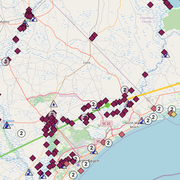Julia G Prokopec
Julia Prokopec is a hydrologist with the Upper Midwest Water Science Center.
She began as a student in 2011 at the Michigan Water Science Center in Lansing, Michigan as a student hydrologic technician. She received her A.S. in Watershed Science from Vermilion Community College in 2012, and her B.S. in Environmental Studies with an emphasis in Geohydrology from Bemidji State in 2014. Julia has worked on projects studying groundwater and surface water interaction, persistence of pesticides in groundwater and surface water, and water quality monitoring. Her focus is hydraulic modeling and flood-inundation mapping where she has led studies to be used by communities for hazard mitigation.
Education and Certifications
A.S., Watershed Science, Vermillion Community College, 2012
B.S., Environmental Studies with an emphasis in Geohydrology, Bemidji State University, 2014













